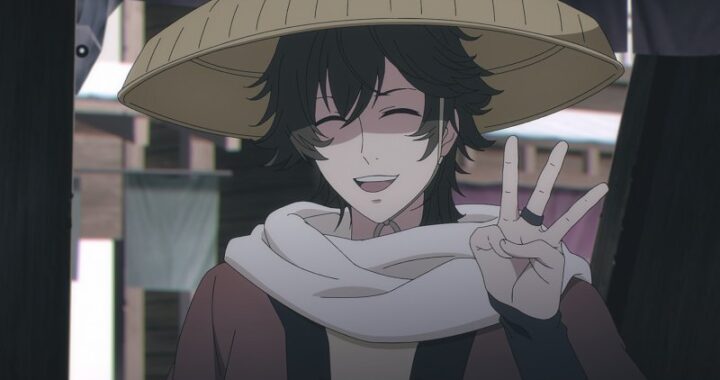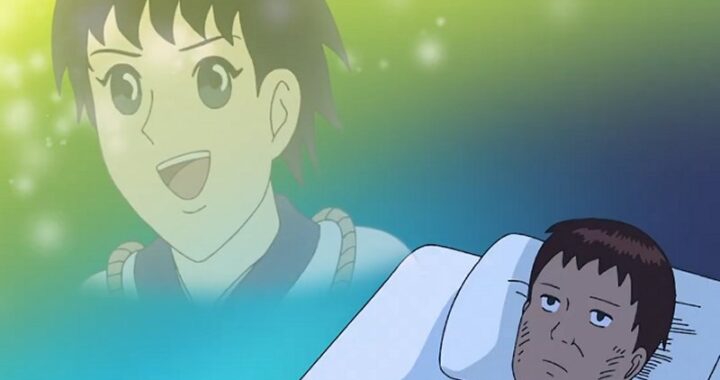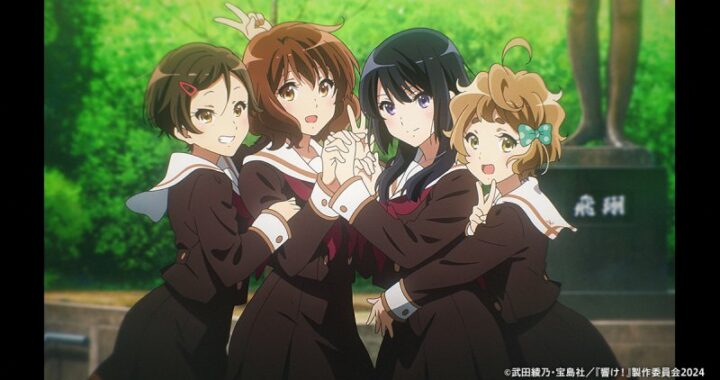
Hiei wants his Evil Eye back.
What They Say:
In celebration of the return of DAN DA DAN, the theatrical premiere, releasing as DAN DA DAN: EVIL EYE, kicks off the thrillingly eerie EVIL EYE arc, which began in the last episode of the first season. The DAN DA DAN: EVIL EYE theatrical event screens last season’s start of the EVIL EYE arc, along with the first three episodes of the new second season, in addition to an exclusive interview with series co-directors Fuga Yamashiro and Abel Gongora. DAN DA DAN follows Momo, a high school girl from a family of spirit mediums, and her classmate Okarun, an occult geek. In this new arc, Momo and Okarun set out on their latest adventure, traveling to a hot springs town home rented by Jiji, Momo’s childhood friend and former crush, with the goal to solve the mystery surrounding his family. When they arrive, strange locals derail their investigation before it can begin, and the group soon learns there’s more lurking under the surface of the town than they could possibly have imagined.
The Review:
Content: (please note that content portions of a review may contain spoilers)
Anime has long gotten away with parading TV series as feature films. The practice of theatrical compilation films of anime goes back half a century. The original Space Battleship Yamato film from 1977 consists of episodes from the 1974 TV series edited together, and it grossed what equates to about $125 million adjusted for inflation. Mobile Suit Gundam was a failure when it first aired in 1979, but by the time it had been chopped up to be shown as the first of three movies in a theater in 1981, 15,000 fans were rushing just to its premiere event, leading to a successful run for the trilogy that firmly established one of the most ubiquitous anime franchises of all time.
The compilation movie never stopped, and the current decade has pushed it a step further. The first Demon Slayer movie was a true film – produced expressly for that format – although anime being anime, it was put through the reverse treatment and subsequently chopped up into TV episodes to ensure maximum profits. But its success – the highest gross of any anime film, Japanese film, or film in Japan, of all time – prompted Aniplex to try their luck with just straight-up releasing the first episode of each upcoming season as a theatrical film a few weeks before TV broadcast and international streaming, and sure enough, while obviously a fraction of the gross of Mugen Train, each attempt at this still raked in around $50 million without any real effort added to an episode all set for its normal broadcast.
Since then, it has become an increasing trend for high-profile anime series to premiere their first few episodes in theaters as a “film” – sometimes not only for the series premiere but, in the vein of Demon Slayer, each subsequent season. Dandadan was one example of this, with its first three episodes shown a month early as First Encounter nine months ago. I didn’t bother going since I had no association with Dandadan at the time but, being a popular anime, naturally it came back to do the same for its second season, despite only having been off the air for five months.
It’s a good thing that the break was so short, because the first season ended with an episode that felt like a “season finale” about as much as this feels like a “film.” They actually started a new arc in the final episode, so much so that this Evil Eye theatrical screening starts with said episode rather than just the first three episodes of the new season. To be fair, this is still more natural than Demon Slayer’s formula of showing the last two episodes of the previous season, which start in the middle of an ongoing plot, and then following them with the first episode of the next one, which starts a completely new one.
Although I didn’t watch those three episodes in their theatrical presentation, I was aware of the episode count packaged as that “movie,” so when I watched the series, I was shocked by how much more effective episode 4 is as a stopping point than episode 3. There truly is no artistry to these decisions; three episodes was just established as the standard for this new trend of cash grabs, and that means the movie ends wherever that third episode happens to end. This is really the same principle that caused the first season to end at such an inappropriate point: the manga exists and is going to be adapted at a consistent pace, but a standard TV season is most commonly twelve episodes, so the season is going to end at whatever point fills up twelve episodes. I do think they could’ve shortened it by one just to allow the second season to start with the beginning of a new arc, but I’m sure there were grown-up factors.
All that aside, hey, guess what? Dandadan is back. True film or no, we get three episodes a month before the first of them would’ve aired, and we get to watch it on a big screen. I don’t hate that. After a recap of the first season and a repeat of its last episode, or at least the latter half or so (without openings and endings I don’t remember exactly where that episode started), we’re right into the consequences of the boys busting through their wall and Momo being attacked by predators. The town is full of creepy old people who reintroduce us to the idiosyncratic tone of Dandadan, and they soon become very relevant to our protagonists and the problems they’re here to solve.
This is skipping ahead to the end – past the end in a sense, even – but perhaps the most valuable inclusion for these theatrical events is the interview with the directors after the episodes. Season 1 director Fuga Yamashiro is joined by his season 2 co-director Abel Gongora, a Spanish veteran of Irish, French, and American animation who worked with Science Saru founder Masaaki Yuasa, became one of the studio’s first employees, and helmed the brilliantly iconic opening sequence of the first season of Dandadan (set to Creepy Nuts’ equally brilliantly iconic “Otonoke”) over a decade later.
The reason I bring this up now is because the directors’ insight significantly informs the stylistic choices throughout the episodes of the arc, especially in how they – like much of Dandadan – pay homage to very specific eras of Japanese film. The series as a whole has a very distinct tone unlike most anime, and the Evil Eye arc uses its setting to be even more specific in that pursuit, which gives this material an identity entirely unique among its more conventional shounen contemporaries. Yamashiro admits that the unusual structuring of beginning of the arc at the end of the first season forced Gongora to work within the style established for the arc before he would become its co-director this season, but also credits Gongora’s own directorial inspiration for adding immensely to the texture of its presentation. While Yamashiro grew up on much of the cinema being referenced, Gongora dedicated himself to researching it, as well as other international media, to help craft this atmosphere.
In addition to these directors’ efforts to elevate the manga and deliver creator Yukinobu Tatsu’s material in a way that fully utilizes their medium, of course Science Saru’s animation continues to excel at the studio’s highest bar since its founding, making it especially rewarding to watch it in all its majesty unfold on a theatrical screen. Perhaps even more importantly is that the directors can’t help but bring up the work of brilliant composer Kensuke Ushio. As they point out, the music ties into the aesthetic of the arc’s setting and also becomes more upbeat and leans on Ushio’s techno sensibilities – one of his several very disparate strengths – when appropriate.
Over the course of three or four episodes, we really get a sense of Dandadan’s wild range of tone and storytelling. From its surreal beginnings to its simultaneously cool, eccentric, and always stylized action and all the various comedy injected throughout, it’s a healthy reminder of how weird Dandadan is and how much its popularity bodes well for the acceptance of weird art. The titular Evil Eye is naturally a central focus of the arc, and we can’t have a new Dandadan character without a classic possession storyline. Under its influence, Jiji essentially looks like a Dragon Ball Z character, and fortunately Okarun’s transformed form fits the shounen badass requirement just enough to make the battle feel natural, while still being very refreshingly quirky all along. Woven into this is the relationship the two have formed, which is probably more important than any of these plot developments.
Of course, that arbitrary three-episode cutoff strikes again, just as it did the first time around, just as the arbitrary twelve-episode cutoff did for the first season, and we get no more of a film ending than we get a film period. Alas, the Evil Eye arc does not fit into four episodes, and as such we’re left with the other edge to this sword – ending on a cliffhanger just means we now have to wait a month and a half to see it resolved instead of just a week. Considering how the first season ended, though, it could be worse, and it probably will be again. Due to this early release of these episodes, the month and a half of waiting is actually a pretty nontrivial percentage of what only ended up being five months since the previous season ended. TV seasons don’t exist anymore. We’re just in a constant flow of content release that occasionally slows down or speeds up. To anyone unfamiliar with this pattern enough to have expected an actual feature film with a beginning, middle, and end, this is probably an awful experience. But as long as we all understand that we’re signing up for the first few episodes of the next season, it’s a grand old time.
In Summary:
Dandadan is back after a mercifully limited six months cut down to five thanks to this early release, giving us several episodes packed into one, a nice large format to watch them on, and extra content featuring the directors digging into the inspirations and creative innovations that produced the next round of this beloved series. It’s not a movie by any means, but it’s a welcome event to celebrate the forthcoming second season and immerse ourselves in the unique setting that harkens back to a classic era of Japanese cinema. These episodes run the gamut of surrealist comedy, gorgeous action, and a touch of sincere emotion. It’ll be great to have Dandadan back each week, and getting this much at once is an absolute treat.
Grade: A



